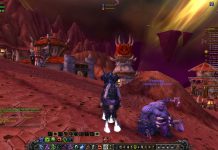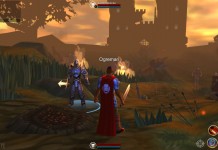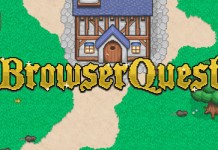Since the dawn of Tolkien and other fantasy writers we have seen the production of games that take advantage of fantasy tropes such as humans, elves, and orcs. Anyone deeply with this particular take on genre fiction into the realm of video games will not be disappointed by Dawn of Fantasy. Developed by Reverie World Studios and published by 505 Games, DoF is a massively multiplayer real time strategy with a solo play option.
Dawn of Fantasy is promoted and distributed as a buy-to-play game that’s free, but only after purchasing the game for $29.99 (on sale right now for $14.99.)
The game was released in 2011 but only after a long road from its initial development in 2001—the game shows this a little bit in its graphical rendering and presentation. Historically, it was originally intended as a mediaeval combat simulation but was reinvented in 2002 as a fantasy game.
Graphics and Sound: Viceral 3D with mediaeval and fantasy units and buildings
Dawn of Fantasy is a 3D real-time strategy game with a staggering amount of fantasy elements. The first thing that pops out about this game is the landscapes that it generates—all maps—but they’re made of mountains, swamps, forests, and any number of brilliantly rendered regions. It’s the sort of graphics that one might expect from a shovelware solo game title with similar gameplay.
When I first entered the game, I played the elves, and the starting map I built my city on had glistening streams, wooden-log bridges, and a canopy of green shadows. The level of the graphics is actually quite high, except that it feels old at the same time. The landscapes are nice and the units are detailed enough to make it a nice game to look at.
I especially liked the way that certain units interacted with the landscape—the dragons especially—dragons have a special ability: fireball and fire wall. In fact, using this ability in a heavily wooded area may wipe out the goblin marauders that might be threatening your troops…but it can also set a small forest fire that will bring smoldering ruin to an area much larger than the initial fireball. Complete with sizzling, flames, and cracking and splintering as the smoking trees fall over.
Like most RTS games, units stand out in the open and wait for the player to select them with the UI or mouse. The game even complains if resource gathering units are standing idle (“There are wardens idle, without a job to do,”) and it warns you if there’s conflict or if your units have entered the fray. Amid the text for reading, there’s a bit of voicing.
Conflict, spells, and units all make sounds, but they’re a little bit forgettable. In the end, it’s perhaps because I’ve played way too many RTS games in my time. Dawn of Fantasy gives me the impression that it’s none too dissimilar from its brethren like a slightly more sophisticated Warcraft II or some other similar fantasy genre real time strategy game.
Gameplay: A standard straight-to-play RTS game that involves a lot of hard developer work
Dawn of Fantasy plays a lot like a standard RTS game and that means resource collection and construction of buildings and units. The game runs on four primary resources that can be collected from the land: food, wood, stone, and gold. The collection of these resources is used for constructing buildings, defenses, and raising units.
Units and buildings are important for offense and defense.
Each of the different factions—men, orcs, elves—have their own benefits, units, and building types. For example, the elves are capable of spawning “Spirit of the Wood” a unit that can collect wood from trees and benefit hugely from ranged and magical units. They also use trees to build their buildings; when the construction happens, scaffolding forms around them and eventually a building that produces or promotes a particular unit type appears. Anyone used to RTS games will be familiar with the resource collection, benefits from buildings, and the movement and control of units on the field of battle.
Although the added element of being able to loot the fallen enemy is an interesting addition.
New users are given a sort of tutorial that allows them to generate a home base, clear it of miscreants—in the case of the elves its small bands of goblins—it also means that I was given a chance to build up my basecamp and prepare to set off on grand adventure. After taking over the local map, it’s possible to start generating armies and taking them out into the world proper, accessible via a world map; it’s also possible to challenge other players to PvP matches.
However, aside from PvP (although this is the main thrust of the game) it’s possible to take on computer-controlled opponents and take their stuff. Many of them, however, are extremely strong and take multiple players at once in order to overcome the challenge. As a result, the game does a fair job of pulling players together, either to fight against one another or alongside each other.
Players are given the opportunity to raise epic armies of fantasy creatures, build powerful siege engines, and even hire dragons and dwarves to fight at their side (these are for-pay critters.) There’s also the prospect of constructing vast castles filled with palisades, casements, and the ability to set up strategy. This means that there’s an element of siege combat and it’s a powerful element of gameplay.
Because of the above, friends can build up their own empires, discover one another using the matchmaking or dueling system, and test themselves against their friends in the PvP. The Dawn of Fantasy forums are full of people looking for friends and prospects in testing out their army makeup, buffs and boons, and buildings against all comers.
Freemium: As a buy-to-play game the addition of a cash shop has some mighty stuff in it
Dawn of Fantasy doesn’t fit the mold of the normal free-to-play game as it’s a buy-to-play title. The game itself costs $29.99 retail price, but that’s just a gateway price to enter into the game world and start playing. After that it’s a full on free-to-play title with a microtransaction currency and a cash shop to support the servers and continued play.
The cash shop contains mostly the usual accoutrements of free-to-play gaming life from boons that increase resource gain and the like.
The item shop also contains extremely powerful units such as dragons. Some of them are quite impressive in firepower and capability. Dragons can dominate a battlefield by being able to wipe out entire groups of enemies or even drop themselves anywhere across the arena. Aside from dragons there are also dwarves who have powerful long-range firepower. It’s hard to tell if the dragons or other elements mean a buy-to-win aspect of the game, but it could if Reverie World doesn’t balance their game correctly.
Conclusion: It’s a fantasy RTS game with much cause to gather friends together
Although recently released, Dawn of Fantasy feels a little bit like it’s showing its age from 2001—although as a 3D game it looks a great deal better than anything from that era because it’s been in constant development for almost a decade. The developers who made this game come from an RTS modding community so there’s a lot of RTS-styled customization to play into. It also has a great deal of unit types, interesting fantasy genre elements, and three factions to choose from.
There’s a bit of a narrative to the game and enough for new players to get into the story alongside understanding how the units work, how to build, and how to prepare themselves for inevitable conflicts.
The graphics are pretty, the units are a great deal of fun—especially the dragons.
This is the sort of game that someone who wants to play against other people, build up their forces, and test their mettle could really get into. Being able to gather together with others to take on stronger NPC opponents and take over the map is probably also another reason to take to this game.























